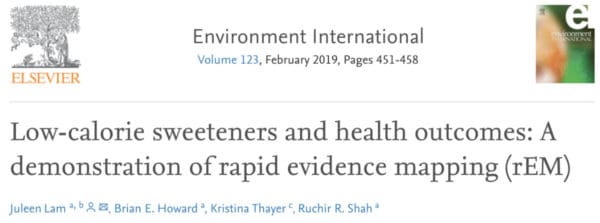Sciome researchers have authored 12 publications so far this year, including three high impact publications with first authorship:
A proof-of-concept case study investigating low-calorie sweeteners (LCS) with respect to human dietary exposures and health outcomes, demonstrating Sciome’s rapid Evidence Mapping (rEM) approach
“rapid Evidence Mapping” (rEM) is a resource-efficient form of knowledge synthesis in which components of the systematic review process are simplified to produce a visual and quantitative representation of the scientific evidence. We show how rapid evidence maps can be created with the aid of Sciome’s text-mining and machine learning software and describe a case study on the topic of low-calorie sweeteners (LCS) with respect to human dietary exposures and health outcomes. The resulting rEM produced findings similar to a traditional evidence mapping of the same topic (Wang et al. 2016) but required significantly less time and resources to create. Furthermore, a sensitivity analysis evaluating the set of studies included at 25% recall (i.e., the point at which the machine learning algorithms predicted we had identified 25% of all relevant references) would have resulted in the same conclusions, suggesting that further efficiency gains can be achieved by mapping only a subset of the available literature. The potential time savings of the rEM approach make it a powerful tool for rapidly translating knowledge to inform science-based decision-making.
Development of a Zebrafish S1500+ Sentinel Gene Set for High-Throughput Transcriptomics
Sciome has been involved in the development and selection of genes for targeted transcriptomic platforms like the human S1500+ sentinel gene set. In an aim to introduce a platform for zebrafish, our strategy was to use human-zebrafish ortholog mapping of the human S1500+ genes and nominations from experts in the zebrafish scientific community. In this study, we present the bioinformatics curation and refinement process to produce the final Zf S1500+ gene set, explore whole transcriptome extrapolation using this gene set, and assess pathway-level inference. This gene set will add value to targeted high-throughput transcriptomics in zebrafish for toxicogenomic screening and other research domains.
An Overview of National Toxicology Program’s Toxicogenomic Applications: DrugMatrix and ToxFX
DrugMatrix and ToxFX are the scientific community’s most comprehensive molecular toxicology reference database and informatics systems. The DrugMatrix database contains results from thousands of highly controlled and standardized toxicological experiments on more than 600 therapeutic, industrial, or environmental chemicals. Study types include toxicogenomics, pharmacology, clinical chemistry, hematology, histology, body and organ weights, and clinical observations. Additionally, a curation team extracted all relevant information on the compounds from many relevant sources. 148 scorable genomic signatures, covering 96 distinct phenotypes were derived from mining the DrugMatrix gene expression data, and are part of the database. The signatures are informative of organ-specific pathology (e.g., hepatic steatosis), and mode of toxicological action (e.g., PXR activation in the liver). The phenotypes cover several common target tissues in toxicity testing (liver, kidney, heart, bone marrow, spleen, and skeletal muscle). Taken as a whole, DrugMatrix enables a toxicologist to formulate a comprehensive picture of toxicity with greater efficiency than traditional methods.
A complete list of Sciome publications is available at: https://www.sciome.com/publications/.




